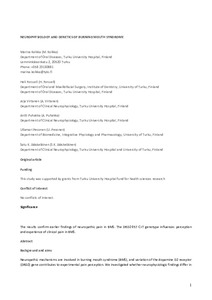Neurophysiology and genetics of burning mouth syndrome
Kolkka M.; Forssell H.; Virtanen A.; Puhakka A.; Pesonen U.; Jääskeläinen S.K.
https://urn.fi/URN:NBN:fi-fe2021042823800
Tiivistelmä
Background and aims: Neuropathic mechanisms are involved in burning mouth syndrome (BMS), and variation of the dopamine D2 receptor (DRD2) gene contributes to experimental pain perception. We investigated whether neurophysiologic findings differ in BMS patients compared to healthy controls, and whether 957C>T polymorphism of the DRD2 gene influences thermal sensitivity or pain experience in BMS.
Methods: Forty‐five BMS patients (43 women), mean age 62.5 years, and 32 healthy controls (30 women), mean age 64.8 years, participated. Patients estimated pain intensity, interference, suffering and sleep with Numeric Rating Scale. Blink reflex tests of the supraorbital (SON), mental (MN) and lingual (LN) nerves, and thermal quantitative sensory testing were done. The results were analysed with ANOVA. DRD2 gene 957C>T polymorphism was determined in 31 patients, and its effects on neurophysiologic and clinical variables were analysed.
Results: Cool (p = 0.0090) and warm detection thresholds (p = 0.0229) of the tongue were higher in BMS patients than controls. The stimulation threshold for SON BR was higher in patients than in controls (p = 0.0056). The latencies of R2 component were longer in BMS patients than in controls (p = 0.0005) at the SON distribution. Habituation of SON BR did not differ between the groups. The heat pain thresholds were highest (p = 0.0312) in homozygous patients with 957TT, who also reported most interference (p = 0.0352) and greatest suffering (p = 0.0341). Genotype 957CC associated with sleep disturbances (p = 0.0254).
Conclusions: Burning mouth syndrome patients showed thermal hypoesthesia within LN distribution compatible with small fibre neuropathy. The DRD2 957C>T genotype influences perception and experience of BMS pain.
Significance: The results confirm earlier findings of neuropathic pain in BMS. The DRD2 957 C>T genotype influences perception and experience of clinical pain in BMS.
Kokoelmat
- Rinnakkaistallenteet [27094]
